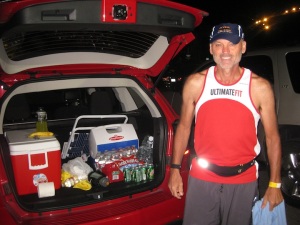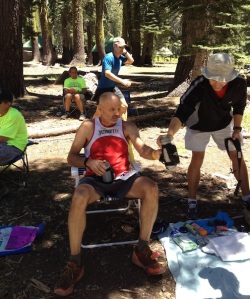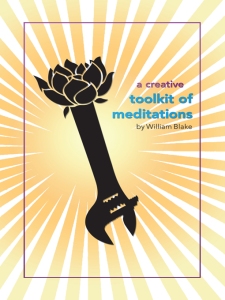(Part One of a Two-Part Blog on this writer’s experience pacing David Nichols in the Western States 100-Mile Endurance Run.)
I’ve enjoyed and written about many peak moments in nature — trekking in the Himalayas,
commingling with curanderos in the Amazon, countless hikes and river swims in the Bavarian Alps, Rockies, Sierra Nevada, Big Sur and dozens of other stunning places. I’ve also experienced a fair share of endurance running — ten marathons, a pair of 24-hour relays, and countless 15- and 20-milers deep into forests and along mountain ridges.
Never have I experienced a greater combination of nature and endurance than the Western States 100-Mile Endurance Run. And I wasn’t even competing. I was a pacer for David Nichols, who traveled from Lexington, Ken. to tackle the mighty Sierra Nevada and, more specifically, the same trail cut by the 49ers during California’s Gold Rush. Along with Dave came my fellow pacer, Evansville, Ind.-based marathoner Craig Luebke, and Dave’s brother Don, our crew chief – the pit boss for our “driver”, as it were.
Western States is the Super Bowl of ultramarathoning. The best 100-milers in the world, along with about 400 super-conditioned athletes, flock to Northern California to duel on terrain and in weather conditions that make you sweat just viewing the topographical maps. Between the start at the Squaw Valley ski resort and finish at the 50-yard line at Auburn’s Placer High School, there are mountains. Passes. Scree-filled escarpments. Nasty ascents and descents. Creek and river crossings. Rocky trails. Sandy trails. Single-track ridge trails from which, if you look over the side, you can see the American River a thousand feet below, ribboning toward Sacramento. Canyons. More canyons…
My guess is that Dave won’t be training through canyons anytime soon. I think after 29 hours of trudging up and down the American River canyon system in heat pushing 100 degrees, he’s good on that experience for a while.
Which brings up the weather. The Sierra Range in early summer is typically very hot, with temperatures approaching 120 degrees in the heat-protected river canyons. At the highest point of the Western States course, 9,000 feet above sea level, it can also be very cold, with several feet of snow still on the ground. Wind is almost always a factor. How does a person deal with all this, and still cover 100 miles in a day?
I drove up to Tahoe City out of both curiosity and commitment, part of a memorable year of racing. As one who will never run a 100-miler, I thought it would be great to taste the experience as a pacer. Also, I’d spent three years in nearby Nevada City as a college professor, during which I’d hiked and run countless miles on similar terrain; local knowledge never hurts. Plus, it would be fun to run with Dave again, after the 5K, 10K and half-marathon duels we had between 2006-2010.
The experience turned out to be far more than I could have imagined. It wasn’t a run. It was a testament to endurance, resilience, adaptability, strength, courage, determination and guts. I could go on and on …
…and that’s what we did. We ran on … and on … and on …

Dave, in front of the fully loaded crew SUV. We’d load and unload the back many times in the next 30 hours.
After three days shopping, running together, setting and re-setting plans for pacing, going to official meetings, and double- and triple-checking gear checklists, Dave and Don declared us ready. The first realization hit me: you are no longer in marathon land, Bob. When racing marathons, you typically don’t eat, nor do you stop for more than a few seconds – if at all. Ultras require eating to sustain the body, plus designated stops on the course for clothes changes, first aid, food, drink, pep talks, and getting weighed to make sure you haven’t lost too many pounds.
It’s not merely a different type of race. It’s a different world entirely.

Craig and I at the top of Squaw Valley’s gondola lift, elev. 8,900 feet, aka the finish line of the Montrail 6K.
The morning before race day, Craig and I entered the Montrail 6K, a 3½-mile up-the-gut ascent from the base of Squaw Valley. We ran up an intermediate to advanced-level ski run, climbing from 6,400 to 8,800 feet. We also scouted for Dave, because he’d be moving up the same hill the next morning – for the first 3½ miles of his 100-miler. Yes, Western States leaves common sense in a cloud of Sierra dust. Aren’t you supposed to go down a ski run? A never-ending stream of quirky moments added to the fun, such as Dave asking me at mile 59 the next night, “Why are we stopping to look at the stars?”
“Because you’ve gotta see them,” I said, breaking into a teaching moment. Guess I reverted to my years at Ananda College, about 50 miles away. “They’re amazing up here… hey, there’s Scorpius. Cygnus. Orion. Cassiopeia…”
“If I miss my time by 30 seconds…”
I did have a reason (which I’ll share later). This type of repartee occurred countless times on the trail, multiplied by 369.
The 369 official entrants started at 5 a.m., and were cheered into the first climb by hundreds of crews, friends and family members. We hustled to Robinson Flat, the first crew stop at the 30-mile mark. We had to drive to Auburn, then drive right back up Foresthill Road – about 110 miles in all. Along the way, we passed through miles of charred forest from last summer’s fire, which would’ve erased this year’s race had volunteers and trail crews not spent nine months restoring 19 miles of trail. Craig and Don also received their first taste of narrow, windy Sierra Nevada upslope roads with their steep turns and four-digit drop-offs, which led to a comical moment involving fear.
“Oh yeah,” I said to Craig, at the height of his angst, “we’ll be pacing Dave on trails with drop-offs like this – at night.” I couldn’t resist.
I’m sure that Craig will exact sweet revenge on me one day in the future.

Where did the smile go? At mile 30, Dave looked tired and depleted. The realization of Western States’ physical brutality had set in.
We waited at Robinson Flat for an hour and a half, during which I marveled at the crew set-ups, the fantastic race organization, and the runners themselves. When Dave came through, he was on goal pace – but looked like he’d run through a desert and smacked a wall. We were concerned. This is not how you want to look or feel with 70 miles still to go and the midday heat cranking up. Don was already feeling an inner tug, as in, “do I act as his crew chief or his worried older brother?” He’d fight that fight a few more times.
A word about Don. The focus of an ultramarathon is the runner, and then the pacers enter the picture for the second half of the race. Hardly ever are support crews recognized. Don is a recently retired, fun-loving Midwesterner, borne of rock & roll and hard work, a former competitive runner in his own right. He did an incredible job keeping us organized with equipment, stops and taking care of Dave’s needs. Every stop required different gear. We made numerous adjustments during the race – the most significant of which I’ll get to – and Don left the running/strategizing portion to Craig and me. However, he took on the tough, unsung stuff, not the least of which was an agonizing instance where he had to talk to his brother about whether or not to leave the race. I vaguely knew Don before this weekend. Now, I know him. He is an amazing group leader.
We took care of Dave, sent him back on his way, and headed down to Foresthill, the only town on the Western States Trail.
Foresthill is a cozy hamlet in the Sierra foothills, about 20 miles outside Auburn. It serves as the symbolic center of Western States, even though it falls 100K (62-mile) into the race. Since we didn’t expect Dave at the next crew stop, Michigan Bluff, for several hours, we pulled up chairs, ate sandwiches, and watched the front of this race – the elites, astonishing in their fitness and efficiency. They passed through town running 7:00 to 7:30 miles, which I’d take for a 26-mile marathon any time. We watched eventual men’s winner Rob Krar run down Max King along the frontage road – one of two strips of pavement on the entire course. We also watched eventual women’s champ Stephanie Howe lope by, her long stride, waist-length hair and 5-foot-10 runway model’s body not what you’d expect for an ultra runner’s physique. Then again, these are outliers. What should we expect?

Craig figures out our revised pacing plan and the pace Dave needs to run, while Don does what any normal person would do on a beautiful, lazy summer afternoon in the Sierras.
Meanwhile, we had work to do. Dave was struggling, and Craig, Don and I had to decide whether to pace him at Foresthill, or pick him up in Michigan Bluff, at mile 55. That would mean extra running for both Craig and me. While we thought about it, our numbers cruncher (Craig) got to work, figuring out what was needed for Dave to finish under time and get that belt buckle. Since I was the first pacer, I prepared my drinking belt, headlamp, flashlight, running gear and gels, and suited up.
Our decision was made after we arrived at Michigan Bluff, once a gold rush boomtown of 3,000, now a sweet enclave of 40 homes. Michigan Bluff was where Leland Stanford (he of the university) set up the first of his mercantiles and ferried supplies from the San Francisco docks to the gold rushers. (To this day, horseback riding remains a ready source of local transportation.) As the sun carried daylight with it into the far horizon, still no sign of Dave. Craig ran to the other side of Michigan Bluff to serve as our lookout. I started stretching as Don switched into big brother mode and entertained the idea of convincing Dave to bow out. “Problem is, he keeps thinking he’s gonna disappoint the rest of us,” Don said. “But I can’t let him stay out there if he comes in here all messed up.”
“I’d never be disappointed. Just getting out there and going this far, on this terrain, in these mountains is quite the accomplishment,” I told him. “I’m just happy to be here with him.” I meant it, though I did relish the chance hit these trails at night.
Finally, Dave popped into view, about 90 minutes behind what we’d expected. Why? He went through hell between 45 and 55 miles, where the American River canyon system kicked into high gear with bone-crunching climbs and falls in high heat. It used to claim prospectors back in the day… and took its shot at Dave as he baked in the relentless sun. Since Dave is from the Midwest, maybe the mountain remembered how it used to punish pioneers.
Dave weighed in – down nine pounds since the race began – and he and Don took the 300-yard walk to our pit stop. I can only imagine what was said. Minutes later, Craig ran up and told me we were pressing on. As I stretched again, Dave showed up, sat down, and we applied cold compresses on his quads, wrapped a cold towel around his neck, reloaded his drinks, and gave our little pep talks. I thought I was in a fight corner between rounds.
We set out at 8:56 p.m. Our goal: to make the river crossing at Rucky Chucky, mile 78, by no later than 4 a.m., hopefully sooner. While that sounds slow to a 5K or 10K specialist, consider the circumstances: Dave had covered 55 miles, the terrain was beastly, and he had to reserve enough strength for the final stretch.
After not running at all for six hours, due to the terrain and his flagging spirits, Dave started jogging again. We bit five minutes off the clock within the first two miles of flat and gentle downslope. Certainly, having another runner with him helped, someone to talk to, especially after spending 16 hours on the course alone. Also, he knew we were running against the clock – a daunting prospect when there’s still 45 miles to go. He had to negative split the race (run the second half faster than the first) … a concept I understand and have done in marathons and shorter races, but boggles my mind when you’re talking about 100 miles.
There was another big change: he began to rehydrate. He’d dehydrated himself beyond the weight crucible Western States sets: if you lose more than 4% of your body weight, they reserve the right to remove you from the race at a weigh station (every 10-15 miles). They rarely do it, but the fear was in his heart. He took extra drink bottles out of Michigan Bluff, and I kept telling him to drink. His legs loosened up, he started running better, and we clicked off time while enjoying beautiful Sierra foothill countryside, along with favorable trail conditions. His legs were celebrating after the mess they’d traversed all day.
At mile 59, as we ascended Volcano Canyon, I decided to make sure he drank up. That’s when I started pointing out the stars. Dave couldn’t figure out what I was doing, but when you’re in the Sierras on a warm summer night, the stars look like golf balls, and it can feel like you’re one with the heavens. If you bust your ass for a hundred miles, you deserve the experience. That’s what I told him. I also made sure that, while stopped and allowing his legs to relax, Dave took his mind off the race for a second and drank every drop, since he could reload at the Bath Road aid station a mile away.
All told, we stopped for a minute. I took a good-natured ribbing on the course for this move, and Craig and Don joined in later. (OK, boys, you’re right: I’m unconventional. But hey, whatever works…)







